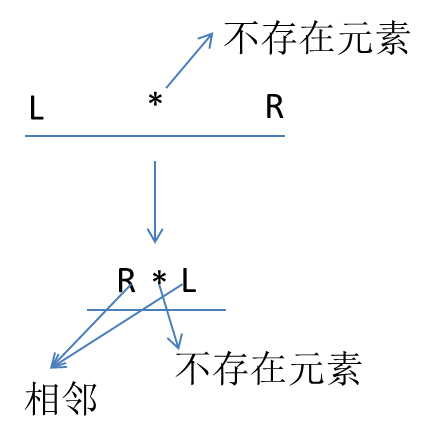二分专题
Points in Segments
Given n points (1 dimensional) and q segments, you have to find the number of points that lie in each of the segments. A point pi will lie in a segment A B if A ≤ pi ≤ B.
For example if the points are 1, 4, 6, 8, 10. And the segment is 0 to 5. Then there are 2 points that lie in the segment.
Input
Input starts with an integer T (≤ 5), denoting the number of test cases.
Each case starts with a line containing two integers n (1 ≤ n ≤ 105) and q (1 ≤ q ≤ 50000). The next line contains n space separated integers denoting the points in ascending order. All the integers are distinct and each of them range in [0, 108].
Each of the next q lines contains two integers Ak Bk (0 ≤ Ak ≤ Bk ≤ 108) denoting a segment.
OutputFor each case, print the case number in a single line. Then for each segment, print the number of points that lie in that segment.
Sample Input1
5 3
1 4 6 8 10
0 5
6 10
7 100000
Sample OutputCase 1:
2
3
2
题目分析 :
对于刚学C++ 的我 , 这题真的好坑我 , 程序写的没问题 , 就是因为输入输出的时候用的 cin , cout ,导致超时 , 找BUG找了好长时间 。
好了 , 下面正式分析题目 , 最开始看这个题就感觉是要用线段树 , 我哪会什么线段树 , 这题直接过 , 后来也是听了题解才知道 , 原来并不用线段树 , 就是用到一个 二分找数组下标 , 用后一个数组下标 - 前一个元素的数组下标 + 1 。
////*****/////
在二分区间找数组下标时 , 若此元素存在 , 直接返回数组下标 。 若此元素不存在 ,一直执行二分 , 二分退出的条件为 Left > Right , 此时被二分的元素一定是夹在 Left 与 Right 中的 , 所以若此元素作为待查询数据的左端临界值 , 则返回Left , 相反则返回 Right 。
附图介绍下 :

////*********/////
代码示例 :
1 2 3 4 5 6 7 8 9 10 11 12 13 14 15 16 17 18 19 20 21 22 23 24 25 26 27 28 29 30 31 32 33 34 35 36 37 38 39 40 41 42 43 44 45 46 47 48 49 | #include <cstdio> #include <iostream>using namespace std ;int pre[100000] ;int search_1 ( int key , int l , int r ) { int mid ; while ( l <= r ) { mid = ( l + r ) / 2 ; if ( pre[mid] == key ) return mid ; if ( pre[mid] < key ) l = mid + 1 ; else r = mid - 1 ; } return l ;}int search_2 ( int key , int l , int r ) { int mid ; while ( l <= r ) { mid = ( l + r ) / 2 ; if ( pre[mid] == key ) return mid ; if ( pre[mid] < key ) l = mid + 1 ; else r = mid - 1 ; } return r ;}int main ( ) { int t , n , q ; int x , y , k = 1 ; cin >> t ; while ( t-- ) { scanf ( "%d%d" , &n , &q ) ; for ( int i = 0 ; i < n ; i++ ) { scanf ( "%d" , &pre[i] ) ; } cout << "Case " << k++ << ':' << endl ; while ( q-- ) { scanf ( "%d%d" , &x , &y ) ; int a = search_1 ( x , 0 , n-1 ) , b = search_2 ( y , 0 , n - 1 ) ; printf ( "%d\n" , b -a + 1 ) ; } } return 0 ;} |
/////////////////////////////////////////////////////////////////////////////////
经过 一番讨论 ,这个题的测试样例还是有水的 , 有一种情况没想到但是是A 了 , 比如 在 3 3 3 中 , 要查找的区间是 [ 0 , 2 ] , 若按照我的方法 , 则返回 L = 0 , R = -1 ; 此时就会出错 , 所以这个题可以再最后在特判两种情况 ,带查找的两数位于 最左边 或 是待查找的两个数 位于最最右边 , 此时特判都应该输出 0 。
////////////////////////////////////////////////////////////////////////////////////////
补充 一种 二分查找数组下标的方法
在一个包含 N 个元素 , 从小到大排序的 int 数组中查找比给定整数 P 小的 , 下标最大的元素 , 找到则返回其下标 , 找不到则返回 - 1 。
代码示例 :
1 2 3 4 5 6 7 8 9 10 11 12 13 14 15 | int searh_low ( int p ) { int l = 0 , r = n - 1 , mid ; int pt = -1 ; // 在初始时刻默认给定的最优解 while ( low <= high ) { mid = l + ( r - l ) / 2 ; if ( a[mid] >= p ) r = mid - 1 ; else { pt = mid ; l = mid + 1 ; } } return pt ;} |
作者:静默虚空
欢迎任何形式的转载,但请务必注明出处。
限于本人水平,如果文章和代码有表述不当之处,还请不吝赐教。



【推荐】编程新体验,更懂你的AI,立即体验豆包MarsCode编程助手
【推荐】凌霞软件回馈社区,博客园 & 1Panel & Halo 联合会员上线
【推荐】抖音旗下AI助手豆包,你的智能百科全书,全免费不限次数
【推荐】博客园社区专享云产品让利特惠,阿里云新客6.5折上折
【推荐】轻量又高性能的 SSH 工具 IShell:AI 加持,快人一步
· Java 中堆内存和栈内存上的数据分布和特点
· 开发中对象命名的一点思考
· .NET Core内存结构体系(Windows环境)底层原理浅谈
· C# 深度学习:对抗生成网络(GAN)训练头像生成模型
· .NET 适配 HarmonyOS 进展
· 手把手教你更优雅的享受 DeepSeek
· 腾讯元宝接入 DeepSeek R1 模型,支持深度思考 + 联网搜索,好用不卡机!
· AI工具推荐:领先的开源 AI 代码助手——Continue
· 探秘Transformer系列之(2)---总体架构
· V-Control:一个基于 .NET MAUI 的开箱即用的UI组件库